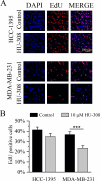Nucleolar sequestration of cannabinoid type-2 receptors in triple-negative breast cancer cells
- PMID: 40359210
- PMCID: PMC12074389
- DOI: 10.1371/journal.pone.0323554
Nucleolar sequestration of cannabinoid type-2 receptors in triple-negative breast cancer cells
Abstract
Multiple investigations have shown that the different types of cannabinoids, phytocannabinoids, synthetic cannabinoids, and endocannabinoids, possess antiproliferative and anticancer properties. The cannabinoid type-2 receptor (CB2R) has been proposed as a central player in tumor progression and has been correlated with the aggressiveness of breast cancer. Using immunocytochemistry and confocal microscopy, in the present work, we studied the expression level and subcellular localization of CB2R in two human triple-negative breast cancer (TNBC) cell lines, corresponding to early (stage I, HCC-1395) and metastatic (MDA-MB-231) stages, and they were compared with a non-tumoral mammary epithelial cell line (MCF-10A). We found that although CB2R was detected at the plasma membrane, it was mainly localized intracellularly, with ~40-fold higher expression in both TNBC cell lines than in MCF-10A (P < 0.0001). Notably, double staining with DAPI or with the nucleoli-specific fluorescent marker (3xnls-mTurquoise2) showed that most of the CB2R overexpressed in the nucleoli of cancer cells. This finding is supported by the fact that CB2R expression was markedly lower in mitotic cells compared to interphase cells (P < 0.0001). Interestingly, exposure of cancer cells to the specific agonist HU-308 reversed the nucleolar sequestration of CB2R while increasing the presence of the receptor in the nucleoplasm and cytoplasm (P < 0.0001). In addition, we found that this agonist reduced both the cell migration (P < 0.05-0.0001) and proliferation (P < 0.001) of TNBC cells. It remains to determine the function and signaling ability of CB2R in the nucleolus. Although our study only includes cell lines (tumoral and non-tumoral), we consider that this feature of nucleolar sequestration of CB2R could be a potential diagnostic marker for TNBC from the early stage.
Copyright: © 2025 Prado-Celis et al. This is an open access article distributed under the terms of the Creative Commons Attribution License, which permits unrestricted use, distribution, and reproduction in any medium, provided the original author and source are credited.
Conflict of interest statement
The authors have declared that no competing interests exist.
Figures






References
-
- Cuthrell KM, Tzenios N. Breast cancer: updated and deep insights. Int Res J Oncol. 2023;6(1):104–18.
MeSH terms
Substances
LinkOut - more resources
Full Text Sources
Miscellaneous

